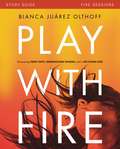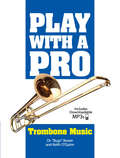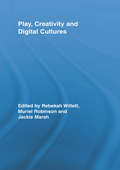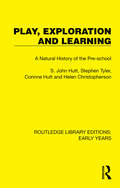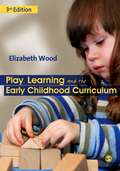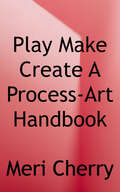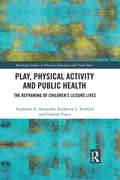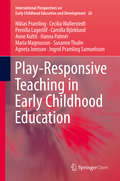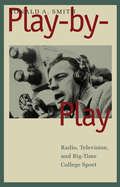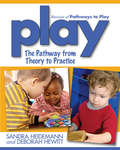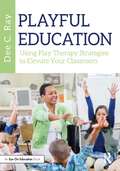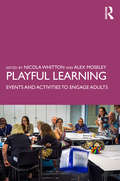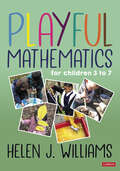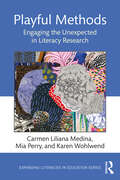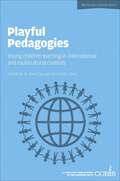- Table View
- List View
Play with Fire Study Guide
by Bianca Juarez OlthoffIn this five-session video based Bible study (DVD/digital video sold separately), Bianca Juarez Olthoff delivers a bible-infused message that will help women gain new insight into God's character, discover the personal and powerful nature of the Holy Spirit, and understand the unique fire God places in each person, helping them to fulfill their God-given calling and Kingdom purpose.Fire can burn and destroy but it can also refine and bring beautiful new life. In each powerful video session you will be reminded, or perhaps learn for the first time, that God has HUGE dreams for you. He's whispering in the wind and speaking through the fire and shouting in silence the extraordinary dream He is birthing in you. His dream for you is far greater than the dream you have for yourself. It's not your identity or income or influence that will make this happen. Like Zechariah 4:6 says, "It's not by might nor by power, but by my Spirit," says the Lord.God isn't waiting until you have more resources or a husband or a job so he can use you. He can use you now. Stop asking when you are going to get your gifts or talents or calling and see what's in your hand. You need to play with some fire.Sessions include:Crying OutSurrenderGod's PromisesCommunityHoly SpiritDesigned for use with the Play with Fire Video Study 97803100880707 (sold separately).
Play with a Pro: Trombone Music
by Keith O'Quinn Dr Bugs BowerFrom Dixieland and boogie woogie to swing, blues, jazz, bop, Latin, and rock music, this title offers a variety of styles. Along with music to fifteen songs, downloadable MP3s provide a chance to play with a top Broadway trombonist.Each song is recorded three ways:1. Practice playing melody (1st trombone) or harmony (2nd trombone) with the title tracks, MP3s 1-15, marked TT.2. Practice playing melody (1st trombone) with accompaniment, MP3s 16-30, marked MT. 3. Practice playing harmony (2nd trombone) with accompaniment, MP3s 31-45, marked HT.These rehearsal routines are comparable to playing a 25-minute set with a live stage band!
Play, Creativity and Digital Cultures (Routledge Research in Education)
by Muriel Robinson Jackie Marsh Rebekah WillettRecent work on children's digital cultures has identified a range of literacies emerging through children's engagement with new media technologies. This edited collection focuses on children's digital cultures, specifically examining the role of play and creativity in learning with these new technologies. The chapters in this book were contributed by an international range of respected researchers, who seek to extend our understandings of children's interactions with new media, both within and outside of school. They address and provide evidence for continuing debates around the following questions: What notions of creativity are useful in our fields? How does an understanding of play inform analysis of children's engagement with digital cultures? How might school practice take account of out-of-school learning in relation to digital cultures? How can we understand children's engagements with digital technologies in commercialized spaces? Offering current research, theoretical debate and empirical studies, this intriguing text will challenge the thinking of scholars and teachers alike as it explores the evolving nature of play within the media landscape of the twenty-first century.
Play, Exploration and Learning: A Natural History of the Pre-school (Routledge Library Editions: Early Years)
by Stephen Tyler S. John Hutt Corinne Hutt Helen ChristophersonOriginally published in 1989, Play, Exploration and Learning was a valuable contribution to the evaluation of nursery practice in Britain at the time, this ‘natural history’ of the activities of children and caring adults presents a comparative study of four types of provision for the under-fives: nursery schools, nursery classes, playgroups and day nurseries. All four types of provision are seen as happy, busy, caring environments, but they vary greatly in terms of staffing levels, training and material provision. The authors look at the ‘play’ of three- to five-year-old children and the activities of the adults who care for them. They examine in detail children’s choices of materials and their use of them, with special attention given to the way language is used by both children and adults during play. They also describe adults’ expectations of the various provisions and the values of the activities pursued in them. Of special interest is the emphasis placed by adults upon fantasy play, and the often large discrepancy between expectation and practice. Also covered are the difference in the play activities of part-time and full-time nursery school children, and the transition from pre-school to first school. The book will still be of historical interest to pre-school practitioners, to developmental psychologists and to educational administrators.
Play, Kitty! (National Geographic Kids Readers)
by Shira EvansPounce! Follow a little kitten through its day to learn all about these young cats. Through text features such as the vocabulary tree and the wrap-up activity, kids will be introduced to vocabulary in concept groups—helping them make connections between words and expand their understanding of the world.
Play, Learning and the Early Childhood Curriculum: SAGE Publications (One-off Ser.)
by Elizabeth Ann WoodThe Third Edition of this popular book reflects contemporary research as well as thinking about the role and value of play in learning and development, within and beyond early childhood. The author explores recent developments across international contexts which endorse play, and argues for critical engagement with some aspects of policy discourse in how 'educational play' is constrructed. This accesible book also reviews contemporary theoretical trends which focus on the meanings and intentions that children bring to their play. The new edition includes coverage of: - play in education policies; UK and international perspectives - working with parents - social and cultural diversity - children with special educational needs and disabilities - outdoor play Each chapter includes case studies provided by practitioners, along with questions and tasks to promote critical engagement and reflection on key issues and debates. This book is for students on Childhood Studies courses and those on Initial Teacher Education and Masters programmes in early childhood and primary education. Experienced practitioners on CPD courses will also find it useful. For additional online material visit www.sagepub.co.uk/wood
Play, Learning, and Children's Development
by Marilyn Fleer Mariane HedegaardThis book explores the dynamics in children's everyday lives as they move between school and the family, with particular consideration of how children's motives change in response new challenges. Professors Mariane Hedegaard and Marilyn Fleer follow four children, two from Australia and two from Denmark, over a twelve-month period. Using these case studies, they show how children's everyday activities, play, and the demands of both family and educational contexts influence their learning and development. The authors contribute to a sociocultural theory formulation that includes the child's perspective in cultural historical contexts. Their approach yields insights that transcend specific nationalities, cultures, and socioeconomic situations. The analysis shows not just how children's family life shapes their experiences in school, but how schools influence and shape their lives at home.
Play, Make, Create, A Process-art Handbook: With 43 Art Invitations for kids creative activities and projects to inspire free thinking, mindfulness, and curiosity
by Meri CherryPacked with joyful and educational art experiences for kids, Play, Make, Create offers fun and engaging imaginative activities focused on the fun and reward of creating, not just producing a final project. Founded in a process-based philosophy, this unique book includes more than 40 activities set up as invitations, or thoughtfully designed prompts to explore, create, and play.
Play, Philosophy and Performance
by Emily Ryall Wendy Russell Malcolm MacLeanPlay, Philosophy and Performance is a cutting-edge collection of essays exploring the philosophy of play. It showcases the most innovative, interdisciplinary work in the rapidly developing field of Play Studies. How we play, and the relation of play to the human condition, is becoming increasingly recognised as a field of scholarly inquiry as well as a significant element of social practice, public policy and socio-cultural understanding. Drawing on approaches ranging through morality and ethics, language and the nature of reality, aesthetics, digital culture and gaming, and written by an international group of emerging and established scholars, this book examines how our performance at play describes, shapes and influences our performance as human beings. This is essential reading for anybody with an interest in leisure, education, childhood, gaming, the arts, playwork or many branches of philosophical enquiry.
Play, Physical Activity and Public Health: The Reframing of Children's Leisure Lives (Routledge Studies in Physical Education and Youth Sport)
by Stephanie A. Alexander Katherine L. Frohlich Caroline FuscoAre children playing less than they used to? Are rising obesity rates linked to a decline in children’s time to play freely? These and other related questions have filled the pages of newspapers, magazines and scholarly journals for the past decade. Researchers and journalists have attributed these issues to societal changes around children’s lives and leisure, the growth of structured and organised activities and increasing perceptions of risk in children’s play. Play, Physical Activity and Public Health presents a discussion of the way modern notions of play are rendering children’s leisure activities less free and less engaged in simply for fun. Based on original qualitative research, and analysis of contemporary media from Canada and elsewhere, this book argues that the growing health concerns around childhood play entail a paradox: by advocating, promoting, discussing, and re-directing children’s play, a new form of children’s leisure is emerging - one that is purpose-driven, instrumentalised for health, and ultimately, less free. We explore how play has become goal-oriented, a means to health ends, and how the management of pleasure in play as well as diverse risk discourses around play continue to limit and constrain possibilities for children and families to play and engage in leisure freely. Incorporating past critiques of this trend in play, we argue for research and practice to create new possibilities and ways of thinking about children's play, leisure, fun and childhood, that are less constrained and managed, and importantly less geared towards health goals. This is a valuable resource for students of the sociology of sport, kinesiology, sports and health psychology, education, public health, and childhood studies. It is also an important read for school teachers, public health practitioners, psychologists, physical education teachers, academics and parents interested in how children’s leisure lives are being shaped by the growing and diverse discussions around play.
Play-Responsive Teaching in Early Childhood Education (International Perspectives on Early Childhood Education and Development #26)
by Niklas Pramling Hanna Palmér Cecilia Wallerstedt Pernilla Lagerlöf Camilla Björklund Anne Kultti Maria Magnusson Susanne Thulin Agneta Jonsson Ingrid Pramling SamuelssonThis open access book develops a theoretical concept of teaching that is relevant to early childhood education, and based on children’s learning and development through play. It discusses theoretical premises and research on playing and learning, and proposes the development of play-responsive didaktik. It examines the processes and products of learning and development, teaching and its phylogenetic and ontogenetic development, as well as the ‘what’ of learning and didaktik. Next, it explores the actions, objects and meaning of play and provides insight into the diversity of beliefs about the practices of play. The book presents ideas on how combined research and development projects can be carried out, providing incentive and a model for practice development and research. The second part of the book consists of empirical studies on teacher’s playing skills and examples of play with very young as well as older children.
Play-based Learning in the Primary School
by Alice Hansen Mary BriggsPlay is an essential part of learning and development for children and is an increasingly important aspect of creative approaches to teaching and learning in primary education. This book demonstrates the value of play in all its different forms as a highly effective medium for teaching and learning across the curriculum. The authors explore how play can be used to increase engagement, motivation and fun in learning situations, examining the theoretical principles of play for learning, types of play for older children, planned and facilitating play-based learning, using thematic approaches when working with individuals, groups and whole classes, in addition to covering important teaching issues such as assessment, inclusion and transition out of primary education. This is recommended reading for students on primary initial teacher education courses including undergraduate (BEd, BA with QTS), postgraduate (PGCE, SCITT), and employment-based routes into teaching, and also for practicing teachers wishing to enhance their own teaching. Mary Briggs is Mathematics and Education tutor at the University of Warwick. Alice Hansen is an educational consultant who works within a number of educational settings and national bodies developing continuing professional development for teachers.
Play-by-Play: Radio, Television, and Big-Time College Sport
by Ronald A. SmithNoted sports historian writes on the relationship of the media to college athletics.Chosen as an Outstanding Academic Title for 2003 by Choice MagazineThe phenomenal popularity of college athletics owes as much to media coverage of games as it does to drum-beating alumni and frantic undergraduates. Play-by-play broadcasts of big college games began in the 1920s via radio, a medium that left much to the listener's imagination and stoked interest in college football. After World War II, the rise of television brought with it network-NCAA deals that reeked of money and fostered bitter jealousies between have and have-not institutions. In Play-by-Play: Radio, Television, and Big-Time College Sport noted author and sports insider Ronald A. Smith examines the troubled relationship between higher education and the broadcasting industry, the effects of TV revenue on college athletics (notably football), and the odds of achieving meaningful reform.Beginning with the early days of radio, Smith describes the first bowl game broadcasts, the media image of Notre Dame and coach Knute Rockne, and the threat broadcasting seemed to pose to college football attendance. He explores the beginnings of television, the growth of networks, the NCAA decision to control football telecasts, the place of advertising, the role of TV announcers, and the threat of NCAA "Robin Hoods" and the College Football Association to NCAA television control. Taking readers behind the scenes, he explains the culture of the college athletic department and reveals the many ways in which broadcasting dollars make friends in the right places. Play-by-Play is an eye-opening look at the political infighting invariably produced by the deadly combination of university administrators, athletic czars, and huge revenue.
Play: A Theory of Learning and Change
by Tara BrabazonThis book examines the question of why 'play' is a happy and benevolent verb in childhood, yet a subjective label of behaviour in adulthood. It studies the transformation of the positively labelled term 'child's play', used to refer to our early years, into an aberrance or deviation from normal social relationships in later life, when we speak of playing up or playing around. It answers the question by proposing play as a theory of learning, an ideology that circumscribes behaviour, and a way of thinking. Written by scholars of early childhood through to further and higher education, the book presents research on play enacted in a way that arches beyond the specificity of age groups or predictive, normative patterns. It is international in its focus, moving beyond insular, inward and parochial educational standards and limitations in one city, province, state or nation. Finally, it demonstrates the value of play to educational policy and theories of learning.
Play: Fun ways to help your child develop in the first five years
by Dr Amanda GummerPlay is a fantastic way to promote family cohesion, enhance child development, reduce stress and encourage parents and children to enjoy their family life. Play is a practical and inspiring book for all parents who want to support their child’s development in a fun and pressure free way. Written by a child development expert and play psychologist, it’s packed with activities and insights to help parents support their child through the critical first five years of life. Find out: · Why babies love peekaboo and how to promote attachment through laughter · What toys to buy and what games to play at each developmental stage and why · How to use musical play to lay the foundations for learning languages and maths · Ways to manage sibling rivalry, tantrums, ADHD and fussiness through games · Activities to increase mobility, creativity, confidence, cognitive and social skills Giving the confidence back to parents, and showing them that the tools they need are already at their fingertips, Play is for every parent who wants a playful and stress-free solution to helping their child to reach their full potential.
Play: The Pathway From Theory To Practice
by Deborah Hewitt Sandra HeidemannPlay skills are life skills; as children develop them, they also learn important social skills that they will use throughout their lives. Teachers will find successful strategies for implementing changes in the classroom to enhance the environment for play and techniques to help support children’s development. This is the revised edition of the well-respected and relied-upon handbook Pathways to Play. Play contains activity ideas that encourage play skills, checklists to help identify where children are having problems, specific teaching strategies, and assessment options. This new edition also examines how play theory translates into practice.
Player Piano
by Arthur A. ReblitzA treatise on how player pianos function, and how to get them back into top playing condition if they don't work. For beginners and experienced technicians alike.
Playful Education: Using Play Therapy Strategies to Elevate Your Classroom
by Dee C. RayPlayful Education provides a guide for you to activate the powers of play to boost your teaching practices and increase your effectiveness as an educator. Based on Virginia Axline and Garry Landreth’s play therapy, this book is an operational and practical guide on using play therapy to strengthen your holistic learning development and relationships with students. Chapters offer practical responsive interventions for children with behavioral and academic challenges and preventative practices. You will learn the purpose and goals of implementing play times, (i.e., PlayBreaks), with individuals and groups of students, skills necessary to facilitate playtimes, and how to transfer play skills to the larger classroom. Educators will learn the foundations of play therapy and how they can be used to guide play within a classroom setting. Expanding beyond the classroom, this book is loaded with playful activities to enhance child-teacher relationships and integrate play throughout the school.
Playful Learning: Events and Activities to Engage Adults
by Alex Moseley Nicola WhittonOffering an innovative and dynamic approach to adult learning, Playful Learning explores the potential of play in adulthood with the goal of helping educators, corporate trainers and event designers incorporate play-based activities for adults into both educational and work settings. Through a comprehensive overview of the value of play in adulthood, this book responds to the growing popularity of playful events for adults in academic and business settings designed to promote higher levels of engagement. Drawing on the authors’ own decades of experience at the forefront of the field, this helpful reference incorporates strategies and techniques for bringing play into any learning design. Examples and case studies of successful playful design at conferences, training events, and in higher education illustrate what effective playful event design looks like in practice. With a multi-sector appeal that spans business, education and entertainment while bringing together practice and theory in an accessible manner, Playful Learning is a must-have resource for researchers, practitioners, managers and administrators alike.
Playful Mathematics: For children 3 to 7
by Helen J. WilliamsNursery World Professional Book of the Year 2022 Children are naturally mathematical in their play. They play with mathematics. Early years’ practitioners often struggle to make mathematics relevant and engaging for their young learners. In their play, children are naturally mathematical yet practitioners are often unsure about how to build on this or how this observed play ‘fits’ in with the mathematics they teach. This Nursery World Award Winning Book: *Empowers early years teachers to see the learning in this play and to remain committed to play based practice *Outlines recent research on how children best learn mathematics *Supports early years practitioners to know why preparation works better than planning and why ′thinking space′ matters more than you think
Playful Mathematics: For children 3 to 7
by Helen J. WilliamsNursery World Professional Book of the Year 2022 Children are naturally mathematical in their play. They play with mathematics. Early years’ practitioners often struggle to make mathematics relevant and engaging for their young learners. In their play, children are naturally mathematical yet practitioners are often unsure about how to build on this or how this observed play ‘fits’ in with the mathematics they teach. This Nursery World Award Winning Book: *Empowers early years teachers to see the learning in this play and to remain committed to play based practice *Outlines recent research on how children best learn mathematics *Supports early years practitioners to know why preparation works better than planning and why ′thinking space′ matters more than you think
Playful Methods: Engaging the Unexpected in Literacy Research (Expanding Literacies in Education)
by Mia Perry Carmen Liliana Medina Karen WohlwendThis book introduces three new subjects to the context of literacy research—play, the imaginary, and improvisation—and proposes how to incorporate these important concepts into the field as research methods in order to engage people, materials, spaces, and imaginaries that are inherent in every research encounter. Grounded in cutting-edge theory, chapters are structured around lived narratives of research experiences, demonstrating key practices for unsettling and expanding the ways people interact, behave, and construct knowledge. Through an exploration of difference, play, and the imaginary, authors Medina, Perry, and Wohlwend present an active set of practices that acknowledges and attends to the global, fragmented, politicized contexts in literacy research. This book provides researchers and literacy education scholars with rich and clear theoretical foundations and practical tools to engage in literacy research in ethical, creative, and responsive ways. The authors invite readers to play by exploring the ways in which pedagogical, research, artistic, and other creative contexts can be sites to examine identity, plurality, and difference. Chapters feature innovative elements such as author dialogues that make visible how the authors engage with the ideas they present; guiding questions to prompt reflection and conversation; playful invitations to share possibilities of play in real-world contexts; and stories and practices to ground the conceptual and playful inquiry.
Playful Pedagogies: Young Children Learning in International and Multicultural Contexts
by Anna Cox Estelle TarryIn the 21st century what the future holds for young learners is unclear, what is clear is that they need to be confident, capable and resilient. As wider communication about education is increasing, there is a developing understanding that children in settings across the globe learn in the same ways and have the same needs. How these are best met demands reflection and effective contexts for early learning reflect the needs and demands of the communities they serve. This book considers international and multicultural learning environments from both theoretical and practical perspectives. It is written by specialists in early years education in the UK and in international contexts, all of whom have a passion for young children's learning. The theoretical perspectives are supported by eight case studies, from Uganda, Indonesia, Mexico, Qatar, Netherlands, Italy, the United Kingdom and Romania.
Playful Pedagogies: Young Children Learning in International and Multicultural Contexts
by Anna Cox Estelle TarryIn the 21st century what the future holds for young learners is unclear, what is clear is that they need to be confident, capable and resilient. As wider communication about education is increasing, there is a developing understanding that children in settings across the globe learn in the same ways and have the same needs. How these are best met demands reflection and effective contexts for early learning reflect the needs and demands of the communities they serve. This book considers international and multicultural learning environments from both theoretical and practical perspectives. It is written by specialists in early years education in the UK and in international contexts, all of whom have a passion for young children's learning. The theoretical perspectives are supported by eight case studies, from Uganda, Indonesia, Mexico, Qatar, Netherlands, Italy, the United Kingdom and Romania.
Playful Pedagogy in Higher Education: Research and Cases from across the Disciplines (Knowledge Studies in Higher Education #14)
by Laura Baecher Lindsay PortnoyThis collection provides a wide array of concrete and inspiring "playful" approaches to teaching in a range of higher education contexts and discipline areas, grounded in the learning sciences and within a future-oriented revisioning of the university learning environment. Within the broad area of active learning strategies, this text offers a curated collection of creative innovations such as game-based learning, gamification of courses, escape rooms, semester-long quests, dramatic role-plays, artistic endeavors and more. Containing descriptive and impact research that evidences the power of playful pedagogy, this text will offer a range of novel, transferable and usable materials for readers to apply in their lecture halls and classrooms tomorrow.
